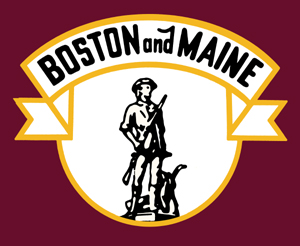
The Boston and Maine Railroad was a U.S. Class I railroad in northern New England. Originally chartered in 1835, it became part of what was the Pan Am Railways network in 1983.
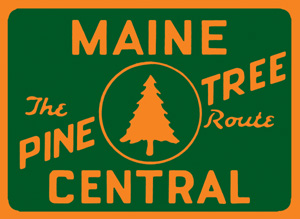
The Maine Central Railroad was a U. S. class 1 railroad in central and southern Maine. It was chartered in 1856 and began operations in 1862. By 1884, Maine Central was the longest railroad in New England. Maine Central had expanded to 1,358 miles (2,185 km) when the United States Railroad Administration assumed control in 1917. The main line extended from South Portland, Maine, east to the Canada–United States border with New Brunswick, and a Mountain Division extended west from Portland to St. Johnsbury, Vermont, and north into Quebec. The main line was double track from South Portland to Royal Junction, where it split into a "lower road" through Brunswick and Augusta and a "back road" through Lewiston, which converged at Waterville into single track to Bangor and points east. Branch lines served the industrial center of Rumford, a resort hotel on Moosehead Lake and coastal communities from Bath to Eastport.

The Providence and Worcester Railroad is a Class II railroad operating 612 miles (985 km) of tracks in Rhode Island, Massachusetts, and Connecticut, as well as New York via trackage rights. The company was founded in 1844 to build a railroad between Providence, Rhode Island, and Worcester, Massachusetts, and ran its first trains in 1847. A successful railroad, the P&W subsequently expanded with a branch to East Providence, Rhode Island, and for a time leased two small Massachusetts railroads. Originally a single track, its busy mainline was double-tracked after a fatal 1853 collision in Valley Falls, Rhode Island.

Pan Am Railways, Inc. (PAR) is a subsidiary of CSX Corporation that operates Class II regional railroads covering northern New England from Mattawamkeag, Maine, to Rotterdam Junction, New York. Pan Am Railways is primarily made up of former Class II regional railroads such as Boston and Maine Corporation, Maine Central Railroad Company, Portland Terminal Company, and Springfield Terminal Railway Company. It was formerly known as Guilford Transportation Industries and was also known as Guilford Rail System. Guilford bought the name, colors, and logo of Pan American World Airways in 1998.
The Grand Junction Railroad is an 8.55-mile (13.76 km) long railroad in the Boston, Massachusetts, area, connecting the railroads heading west and north from Boston. The line is notable for its railroad bridge over the Charles River that passes under the Boston University Bridge between Boston and Cambridge, Massachusetts.
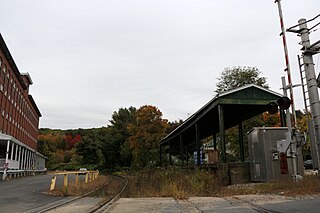
The Massachusetts Central Railroad is a short line railroad in western Massachusetts, United States. It was established in 1975 to provide railroad transportation services on portions of the Boston & Maine Wheelwright Branch in and around their trackage in Bondsville and Ware, and later between Palmer and South Barre on the old Right of Way (ROW) of the Ware River Railroad.
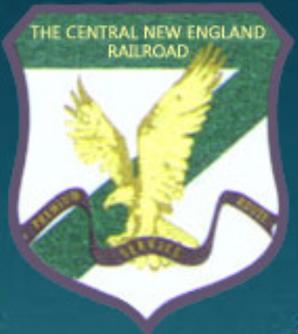
The Central New England Railroad is a railroad in and near Hartford, Connecticut. It began operations in 1995 on former Conrail trackage.

The Connecticut Southern Railroad is a 90-mile (140 km) long short-line railroad operating in Connecticut and Massachusetts. The company was formed in 1996 as a spinoff of Conrail by shortline holding company RailTex and subsequently acquired in 2000 by RailAmerica. Since 2012, it has been a subsidiary of Genesee & Wyoming. CSO is headquartered in Hartford, Connecticut, site of its Hartford Yard. The company also operates East Hartford Yard.
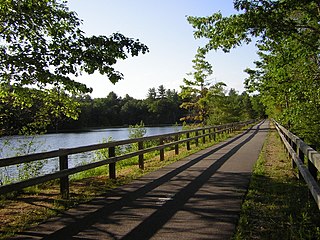
The Nashua River Rail Trail is a 12.5-mile (20.1 km) paved mixed-use rail trail in northern Massachusetts and southern New Hampshire under control of the Massachusetts Department of Conservation and Recreation (DCR). It roughly follows the course of the Nashua River, passing through the towns of Ayer, Groton, Pepperell, and Dunstable, Massachusetts and ends about a mile across the New Hampshire state border in Nashua, New Hampshire. The trail is used by walkers, cyclists, inline skaters, equestrians, and cross-country skiers.
The Lexington and West Cambridge Railroad was a railroad company chartered in 1845 and opened in 1846 that operated in eastern Massachusetts. It and its successors provided passenger service until 1977 and freight service until 1980 or early 1981.

The East Junction Branch is a rail line in Rhode Island and Massachusetts, in the United States. Originally built by the Boston and Providence Railroad (B&P) in 1835, the line connects Attleboro, Massachusetts, and East Providence, Rhode Island via Seekonk, Massachusetts. As built, the line continued across the Seekonk River to Providence via the India Point Railroad Bridge; this connection was removed during the 1970s. The East Junction Branch meets the Northeast Corridor in Attleboro at a point known as East Junction, and ends at a connection to the East Providence Branch in East Providence. CSX Transportation operates freight service on the branch in Attleboro, while the Providence and Worcester Railroad (P&W) operates freight service in East Providence and across the state line into Seekonk. The line is owned by the P&W in Rhode Island, and by the Massachusetts Bay Transportation Authority in Massachusetts.

Ayer station is an MBTA Commuter Rail station located off Main Street in the Ayer Main Street Historic District of Ayer, Massachusetts. It serves the Fitchburg Line. There are three tracks through the station, two of which are served by a pair of low-level side platforms, which are not accessible. There is a shelter on the inbound platform.

Pan Am Southern, LLC is a freight railroad jointly owned by Norfolk Southern Railway (NS) and CSX Corporation. PAS is independently operated by the Berkshire and Eastern Railroad, a subsidiary of Genesee & Wyoming. PAS owns trackage known as the Patriot Corridor between Albany, New York, and the Boston, Massachusetts, area, utilizing rail lines formerly owned by the Fitchburg Railroad and later on the Boston and Maine Railroad. It was previously operated by PAR subsidiary Springfield Terminal Railway.

The South Reading Branch Railroad or just South Reading Railroad was a short line railroad that ran from Wakefield, Massachusetts to Peabody, Massachusetts. Its origins began sometime in 1850 when the railroad was named after the town of South Reading before its name change to Wakefield in 1868. By the time Boston and Maine took over the railroad in 1884, the line had already become obsolete due to competing branches. Boston and Maine eventually halted passenger service in 1925 by abandoning 8 miles of track between Peabody and Lynnfield. The tracks of the former Wakefield branch continued to operate from Lynnfield to Boston until 1959 when passenger service ended. The remaining tracks were then used for freight service from Salem through Peabody Square to South Peabody to serve industrial parks until October 2023.

The Stony Brook Railroad, chartered in 1845, was a railroad company in Massachusetts, United States. The company constructed a rail line between the Nashua and Lowell Railroad's main line at the village of North Chelmsford and the town of Ayer, Massachusetts where it connected to the Fitchburg Railroad. Rather than running its own trains, upon opening in 1848 operations were contracted to the Nashua and Lowell; this arrangement continued until the Nashua and Lowell was leased by the Boston and Lowell Railroad in 1880. The Boston and Maine Railroad (B&M) took over operation of the Stony Brook in 1887 when it leased the Boston and Lowell Railroad. In 1983 the B&M was purchased by Guilford Rail System, which renamed itself Pan Am Railways (PAR) in 2006. Passenger service last ran on the line in 1961, but it saw significant freight service under Pan Am Railways. While it never owned rolling stock or ran trains, the Stony Brook Railroad Corporation existed until 2022 as a nearly wholly owned subsidiary of the Boston and Maine, itself a PAR subsidiary. That year, it was merged into CSX Transportation as part of CSX's purchase of Pan Am Railways.
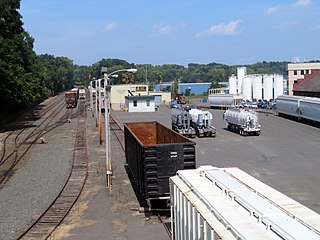
The Pioneer Valley Railroad, founded in 1982, is a Class III short line freight railroad operating the former Conrail trackage in the western part of Massachusetts in towns of Westfield, Holyoke, and Southampton. The railroad has been owned by the Pinsly Railroad Company since its founding, with headquarters in Westfield, Massachusetts.
The Portland & Rochester Railroad, established in 1867, was an important predecessor railway of the Rochester to Portland branch line of the Boston and Maine Railroad. It was founded in the merger of several smaller shortline rail transport companies, the oldest being the shortline York and Cumberland Railroad which was formed in 1846 to connect the seaport facilities of Portland, Maine, to the water powered manufacturing and textile industries along the Quampheagan Falls on the Salmon Falls River in the twin towns of South Berwick, Maine, and Rollinsford, New Hampshire .

The Nashua, Acton and Boston Railroad (NA&B) was a railroad formed in 1871 to build a line between Nashua, New Hampshire, and Acton, Massachusetts. After opening in 1873, the railroad expanded to Concord, Massachusetts, and offered a commuter connection to Boston. It was leased by the Concord Railroad in 1876, with the lease later passing to the Boston and Maine Railroad in 1895. Most of the railroad line was abandoned in the 1920s, though a short portion in Nashua continued to be operated until 1980.

Railroads have played an important role in New England ever since the Granite Railway, America's first commercial railway, began operations in Massachusetts in 1826. As industrialization spread across the region, hundreds of railroads were built throughout the 19th century. Railroad mileage peaked around World War I, and from that point on mileage began to shrink. Despite this, railroads continue to be important for freight and passenger transportation in the region, with the New Haven Line holding the title of busiest railroad line in the entire United States.

The Nashua and Lowell Railroad (N&L) was a 14-mile-long (23 km) railroad built to connect Nashua, New Hampshire with the city of Lowell, Massachusetts. Chartered in June 1835, construction began in 1837 and the first train ran the next year. The Nashua and Lowell was the first railroad built in the state of New Hampshire.


















